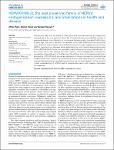HERV-K(HML-2), the best preserved family of HERVs: endogenization, expression, and implications in health and disease
Hohn, Oliver
Hanke, Kirsten
Bannert, Norbert
Retroviruses that have the ability to infect germ line cells can become an integral and inherited part of the host genome. About 8% of the human chromosomal DNA consists of sequences derived from infections by retroviruses that presumably circulated 2–40 millions of years ago, and some elements are actually much older. Post-insertional recombinations, deletions, and mutations have rendered all known human endogenous retroviruses (HERVs) non-infectious. However some, particularly the most recently acquired proviruses of the HERV-K(HML-2) family, can expresses viral proteins and produce viral particles. In this review we will first discuss the major aspects of the endogenization process and peculiarities of the different HERV-K families. We will then focus on the genes and proteins encoded by HERV-K(HML-2) as well as inactivation of these proviruses by postinsertional mutations and their inhibition by antiretroviral factors. After describing the evolutionary interplay between host and endogenous retrovirus we will delve deeper into the currently limited understanding of HERV-K and its possible association with disease, particularly tumorigenesis.
Files in this item
No license information

